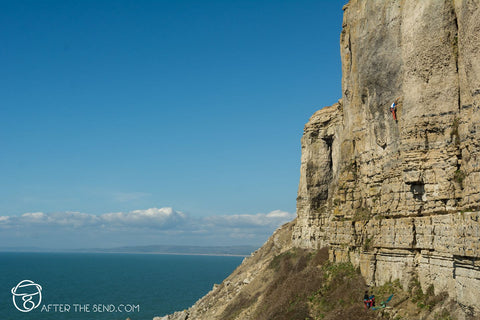September 18, 2018
DISCLAIMER – This blog is intended only to increase awareness of the dangers of outdoor climbing and in no way does the author take responsibility for the actions of other climbers or any events that may occur whilst climbing outside. All climbers enter into the activity of outdoor climbing at their own risk and should always be aware of the possibility of serious injury or death.
As outdoor climbers, we accept that there is a degree of risk associated with climbing on rock, whether it be a quarried, blocky face, or a weather-battered sea cliff full of cracks, but are we really prepared for the occurrence of random rock fall or landslides? Have you ever thought about what you would do if the ground you were belaying on suddenly dropped from beneath you? Or if you were climbing a route and Smart-car-sized blocks of rock started to fall from above you with no warning? Do you even consider that this could happen? In a world where most of us climb at indoor gyms where everything is solid and safe, it’s easy to transfer that complete trust to the rock when we go outside.
I started climbing at a much older age than the majority of people (36 years old in fact), and I often wonder if this means I have come at it with a slightly different approach and awareness of risk than I may have done if I’d started climbing decades earlier. Perhaps some of us older climbers may have an unnecessarily reserved attitude to risk, but rockfalls do happen, landslides do occur and holds do break off. It’s not a matter of scaring people here, it’s a matter of being aware of the risks of climbing in Mother Nature and not being too blasé when you’re out and about on the crags.
INDOOR TO OUTDOOR TRANSITION:
A huge number of indoor climbers make the transition to outdoor with a complete lack of understanding of the risks associated with outdoor sport or trad climbing. Sometimes, people genuinely just don’t know or give it a thought, it’s simply a matter of being blissfully unaware of the risks thanks to a long time climbing on solid wood constructions indoors with plastic holds that don’t snap off. Other times it may be ignorance, or even ego, that causes people to think they’re invincible and that the cliffs we climb on really are as solid as a rock. If you're thinking of going outside for the first time, or even if you go regularly, it's good to have a re-cap and a bit of think about the possible dangers you might face.
LANDSLIDES:
The photo below shows the colossal landslide that occurred at Portland in Dorset in February 2014. The massive amounts of rock, mud and large boulders that slid from the top and base of the cliff, thanks to months of rain and cold weather, was jaw dropping. It took out complete crags along the west coast of Portland in the middle of the night, luckily a time when nobody was walking or climbing in the area. This landslide happened just when I started climbing and it opened my eyes to at least one of the risks associated with climbing on sea cliffs along that coast. I had no idea that the ground leading up from the boulder beach to the path at the base of the crags is essentially a honeycomb of boulders, mud and vegetation, looking solid from above but full of air pockets from below. I realise this is not the case for a lot of climbing areas but with the popularity of sport climbing in the South of England increasing, more and more people are visiting these crags, hence the example. I wonder how many people fully check out their surroundings or the stability of the ground they are standing on, whether it’s the south coast or anywhere else in the UK, or abroad?

ROCKFALLS:
As an example, in the Portland and Swanage areas where we climb rockfalls happen reasonably often. Areas in Portland, particularly Cheyne Weares and Blacknor Central, are prone to some serious choss and rockfalls. Reports of fridge sized blocks falling from the cliffs are frequently described on the UKClimbing logbooks or on social media. Just two weeks ago, blocks fell from the cliff at Blacknor Central with no warning, rolling down the honeycomb mud and boulder slope and narrowly missing some climbers at the Diamond Slab area below on the boulder beach. Luckily, no one was hurt, just a few shaken climbers that day. This particular area is known by the locals as being loose and dodgy, but how many climbers visit the area that don’t read the UKC logs or even own a Dorset climbing guide book where there are warnings about the approaches and chossy climbs (albeit that guide is now six years old and doesn’t cover the recent changes to the land or the cliffs)? The photo below is of the area the recent rockfall took place, looking reasonably solid from a distance but the bands of rock become increasingly loose as you move along the coast northwards.

So, what can you do to stay safe? We should all remember that there will always be risk and the land will do what the land will do, but there are a few things you can do to help yourselves:
Photo credits - Thanks to Sam at After the Send for the fantastic photos.
Author - Rob Rendall.
Comments will be approved before showing up.
Sign up to get the latest on sales, new releases and more…
© 2025 Pongoose Ltd.
All rights reserved.
Powered by Shopify
